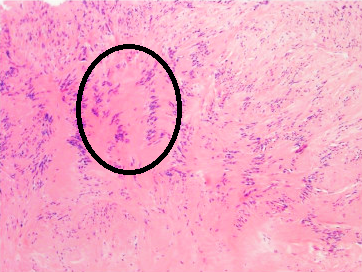Verocay Body


Verocay bodies were first described by Uruguayan neuro-pathologist José Juan Verocay (born: 16 June 1876, Nuevo Paysandú, Uruguay; died: 1927) in 1910. It is a required histopathological finding for diagnosing Schwanommas. Verocay Bodies are a component of Antoni A which are the dense areas of schwannomas located between palisading spindle cells found in neoplasms. Two nuclear palisading regions and an anuclear zone make up 1 Verocay Body.
Naming History: Originally Verocay bodies were called 'neuromas', a term coined by Louis Odier in 1803. The name changed to ‘neuro-fibroma’ under Von Recklinghausen and later in 1935 to ‘neurilemmomas’ curtesy to Arthur Purdy Stout. When Harkin and Reed coined the term 'schwannoma' in 1968, Verocay bodies received its present-day name.
H/P features: 1.Eosinophilic acellular area due to overexpression of lamins.
2.Consisting of reduplicated basement membrane and cytoplasmic processes.